Gluten-Free Peach Cobbler Recipe, Top 8 Free, Allergy Friendly
by Heidi Bayer
I look forward to making gluten-free, allergen-free peach cobbler every summer. I prefer fresh peaches from the farmer’s market, but frozen peaches work just as well in peach cobbler and are a great time-saver.
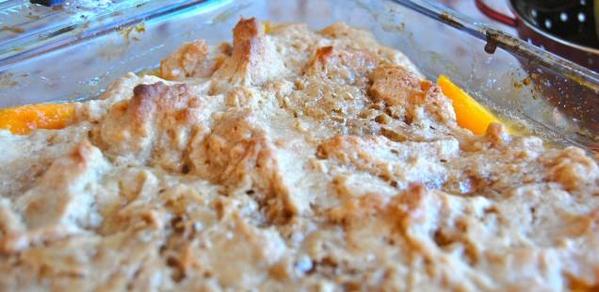 Gluten-Free Allergen-Free Peach Cobbler ©bklynallergymom
Gluten-Free Allergen-Free Peach Cobbler ©bklynallergymom
Another staple I add to my baked goods is brown rice protein powder and calcium powder with vitamin D.

Brown Rice Protein Powder and Calcium Powder ©bklynallergymom
This recipe is based on a recipe by Amy Hugon that first appeared in the Kids With Food Allergies’ cookbook published in 2009 entitled BAKER'S DOZEN; KFA’S FAVORITE SWEETS AND TREATS. You can see by the picture that it is a little worn from many baking sessions and also has my notes of my changes to the recipe.
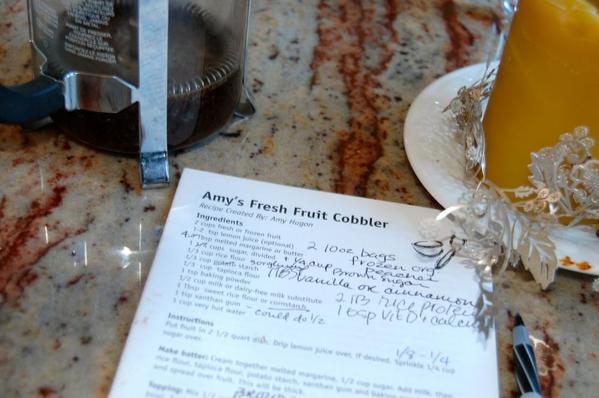
Picture of dog-eared page from “Baker’s Dozen” – recipe by Amy Hugon ©bklynallergymom
GLUTEN-FREE PEACH COBBLER
top 8 free: egg free, dairy free, soy free, nut free, peanut free,
fish free and sesame free
©2012 by Heidi Bayer All Rights Reserved
recipe based on: AMY’S FRESH FRUIT COBBLER by Amy Hugon
Ingredients
For the Fruit:
(2) 10 oz bags of frozen peaches or similar amount of fresh peeled and sliced peaches
Juice from 1/2 a lemon
1/8 – 1/4 cup sugar (for tossing the peaches)
For the Batter:
1/3 cup sorghum flour
1/3 cup brown rice or maseca flour
1/3 cup tapioca flour
2 Tbsp brown rice powder
2 tsp calcium powder
1/2 cup sugar
1 tsp baking powder
1 tsp xanthan gum
1 Tbsp Vanilla
4 Tbsp melted shortening (earth balance, or similar)
1/2 cup rice milk, Apple Juice or similar liquid
For the Crumble:
1/2 cup brown sugar
1 Tbsp cornstarch (sub potato or tapioca)
1 cup very hot water
Instructions:
Turn on your oven to 375 degrees.
Defrost fruit if frozen. Place fruit in a 2 1/2 quart dish or pan (if you’re using a pan, make sure to grease it). Squeeze lemon juice over, then sprinkle 1/8 – 1/4 Cup sugar over and toss.
To make the batter, melt the shortening and let cool a bit. Cream the shortening, sugar and milk substitute on low until well mixed. Add the flours, baking powder and xanthan gum and continue to mix on low until the batter begins to thicken to a taffy like consistency. Spread the mixture over the fruit with your hands and a spatula. The batter will be thick and it should cover the peaches well.
For the crumble, combine 1/2 cup of light brown sugar with a scant tablespoon of cornstarch and mix with your hands crushing any of the larger bits of brown sugar.
Add the crumble evenly to the top of the batter. This will seem like a lot of crumble for the batter, but add away – you will see how wonderful this comes out in the end.
The last step is to add the very hot water. Not tepid, not room temperature – but hot. Pour it delicately over the crumble and batter, until it comes up to about 3/4 high on the side of in the pan. Do NOT skip this step.
Your peach cobbler is now ready to be placed in the warm oven and will look like this:
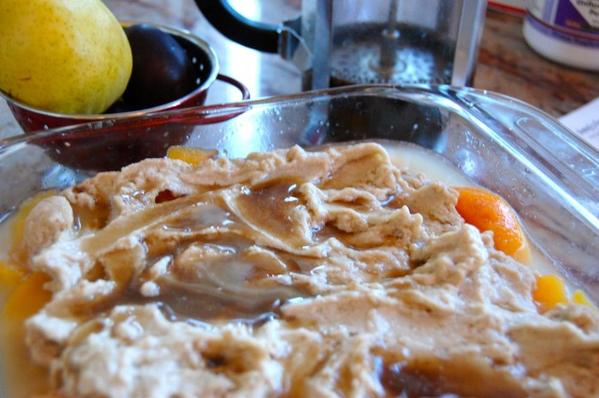 What Peach Cobbler looks like after water is poured over it. ©bklynallergymom
What Peach Cobbler looks like after water is poured over it. ©bklynallergymom
Place in the 375 degree oven for 45 minutes turning it halfway.
Let cool before eating. If you make this for breakfast, I guarantee you that you will have no leftovers by the end of the day. Enjoy and thanks again to Kids With Food Allergies for giving me permission to share my version of Amy Hugon’s fantastically brilliant recipe.
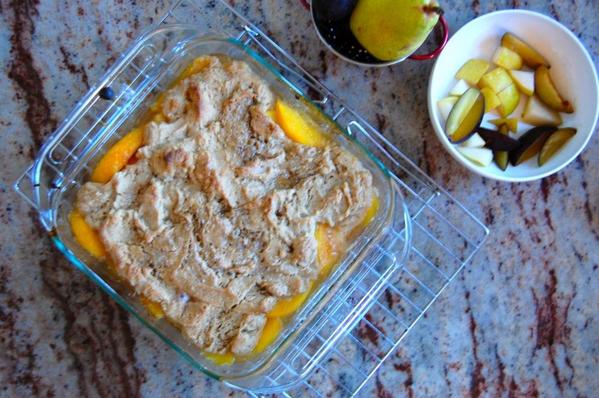 Gluten-Free Allergen-Free Peach Cobbler ©bklynallergymom
Gluten-Free Allergen-Free Peach Cobbler ©bklynallergymom
*Notes: You may sub regular wheat flour for the gluten-free flour mixes 1:1. If you can’t have any milk sub, you can sub water or 7Up or soda. If you want to reduce the amount of sugar, you can omit the sugar in the fruit step, and also reduce by the sugar in the batter to 1/4 cup. Any oil can be subbed including olive oil, or grapeseed.
Heidi Bayer has been managing her daughter's food allergies and a member of KFA since 1998. She runs the Brooklyn Food Allergy Caregiver support group and is the Board Chair for Kids With Food Allergies and on the national board of directors for the Asthma and Allergy Foundation of America.



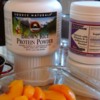




Comments (4)